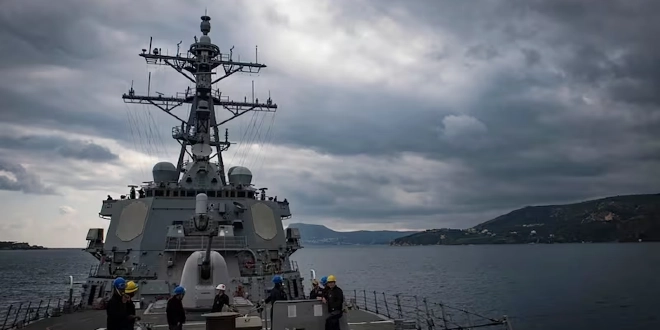Yemen’s Houthi rebels have intensified their maritime hostilities, launching a missile at a U.S. Navy destroyer, the USS Carney, in the Gulf of Aden. This aggressive action necessitated a defensive response from the U.S. warship to intercept the missile. Additionally, a British ship also came under attack as part of the Houthis’ ongoing offensive against naval traffic.
The incident with the USS Carney marks a significant uptick in tensions, representing the most severe naval confrontation involving the U.S. in the Middle East in many years. The Houthis’ actions have escalated further with another commercial vessel being targeted and set on fire on Friday night.
In response to these threats, U.S. forces conducted a preemptive strike early Saturday against a Houthi anti-ship missile poised for launch into the Red Sea, as reported by the U.S. Central Command.
Al-Masirah, a Houthi-affiliated news outlet, confirmed these strikes near Hodeida but did not provide details on the damage caused.
This recent assault on the USS Carney is the first direct attack on a U.S. naval vessel by the Houthis since their offensive against maritime targets began in October. This was disclosed by a U.S. official under anonymity.
On the same day, the United Kingdom Maritime Operations acknowledged that a missile struck and set ablaze a vessel in the Gulf of Aden.
Houthi spokesperson Brig. Gen. Yahya Saree, while not mentioning the Carney incident, admitted to the missile strike on a commercial ship, identifying it as the Marshall Islands-flagged tanker Marlin Luanda.
The U.S. Central Command later confirmed that the Marlin Luanda was hit by a Houthi-fired missile from Yemen. U.S. Navy and coalition ships responded, offering assistance to the damaged vessel. No casualties were reported.
These direct assaults by the Houthis on U.S. naval forces mark a dramatic escalation in their Red Sea campaign, coinciding with the Israel-Hamas conflict. The U.S. has cautiously described the Houthis’ strikes, partly to avoid the conflict escalating into a broader regional war.
The U.S. and its allies had initially refrained from targeting Houthi weapon sites in Yemen but have since begun regular preemptive strikes on imminent threats.
Despite the direct targeting of the Carney, the U.S. Central Command stated the Houthis fired “toward” the warship. The destroyer successfully intercepted the missile.
Brad Bowman from the Foundation for the Defense of Democracies emphasized the significance of acknowledging these actions as direct attacks on U.S. forces.
The Houthi’s campaign against maritime traffic in the Red Sea, disrupting global trade, has been part of their response to Israel’s actions in Gaza.
Since the outbreak of hostilities, the U.S. and Britain have conducted airstrikes on Houthi missile and launcher sites in Yemen, a country embroiled in conflict since the Houthis seized Sanaa in 2014.
In retaliation, the Houthis have targeted various ships in the Red Sea, often unrelated to Israel, and now threaten U.S. and British vessels. Recently, two American-flagged ships were attacked, prompting defensive action from a U.S. Navy escort.
These developments represent the most severe maritime conflict in the region since the 1980s ‘Tanker War’, which culminated in a significant naval skirmish between the U.S. and Iran, including the tragic downing of an Iranian passenger jet by the U.S. Navy in 1988, resulting in 290 casualties.


